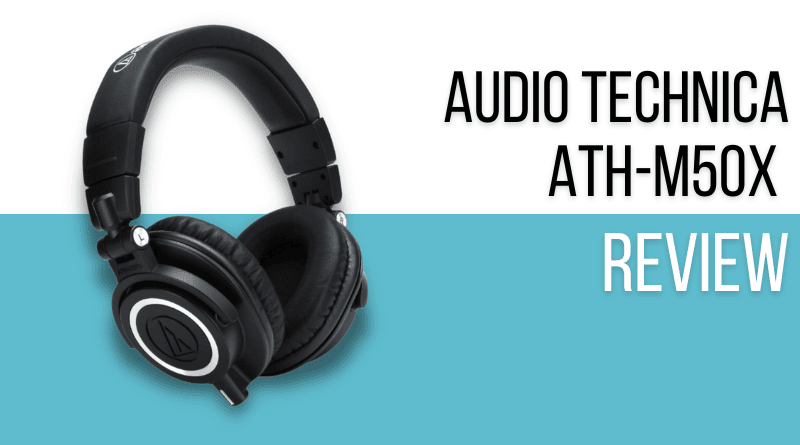Anybody who has tried recording guitar at home using either their laptop speakers, or even studio monitors has likely encountered what the vast majority of us who get started in home recording find – that tones just don’t quite sound right.
The explanation is actually pretty simple – even with high end studio monitors, unless the room you’re mastering from is properly treated, your output will be colored and you won’t be getting a true representation of your recordings. This is where quality studio monitoring headphones like the Audio Technica ATH-M50x come into play!
By using monitoring headphones, you’re taking the unknown equations of your room out of the picture, and getting the most accurate reflection of how your amps and sims really sound.
In this KillerGuitarRigs Review, we’ll be taking a deep dive into the Audio Technica ATH-M50x Closed Back Studio Monitoring headphones. The headphones were provided by our friends at Sweetwater for the purposes of this review, but as always, they provided zero input or direction, and asked for honest opinion – which is exactly what you’ll get.
If you’re looking to upgrade your home studio rig with some quality headphones, you’ll definitely want to keep on reading!
Read more about our review process.
Contents
Who is This For?
These Audio Technica ATH-M50x closed back headphones are a great intermediate to advanced level headphone aimed at those who are starting to take their home recording a bit more seriously. They’re not exactly a budget model, but they still come in at an attainable price point, so you should be able to add them to your rig without breaking the bank.
Appearance/features/controls
Aesthetically, these headphones have a pretty classic look. They’re black, with some silver accents, and relatively subtle branding across the band.
Like most Audio Technica products, they were really well made, and felt solid. The hinged joints moved freely, but with just the right amount of resistance – this gave them a pretty premium feel, which was definitely appreciated. The ear cups were able to swivel a full 90 degrees, and they had a fully collapsible design.
For storage convenience, they came with a nice pouch. They also came with detachable cables. One minor gripe here is that the cable connection is proprietary, which limits choices for replacement cables or upgrades to Audio Technica, but as long as you look after it, or you’re not interested in upgrading, this should be fine.
The included cables included a stretchy 9.8’ coiled cable, a straight 9.8” cable, and a straight 3.9’ cable. All were straight pull to prevent the kind of damage that occurs when standing up too fast – we’ve been there!
Driving these headphones was a pair of 45mm neodymium magnets, which are widely considered to be the optimum alloy due to their permanent magnetism. They offer a wide 15Hz to 28kHz frequency response
These particular units had a closed back design, and came with plush circumaural ear pads.
Performance/Sound
There’s a strong reason why these headphones are one of the most popular choices for studio and live engineers alike. They did an amazing job at presenting the mix as one cohesive unit, which really allowed us to properly dial in the guitars to prevent overcrowding, or from being washed out.
Tonally, they were pretty flat. If you’re upgrading from regular headphones, particularly from the likes of Beats or Bose, you’ll notice a huge difference. They aren’t boosted at any part of the frequency spectrum, which is intended to make sure you hear your amps exactly as the manufacturer intended. The balance across the mid range was excellent, and was ideal for guitars.
Another benefit of the flat response was that they didn’t cause ear fatigue. Headphones with excessive bass or treble response tend to numb your ability to pick out fine detail over time, but with the ATH-M50x, we found that prolonged mixing sessions were a breeze to get through.
The closed back design really did a great job of killing sound bleed, so if you’re recording vocals, you won’t need to worry about sound from inside your cans polluting your track. Despite not being active noise canceling headphones, they still did a good job with noise isolation from the outside in.
They weren’t only good for recording, but we also loved them for practice. We were able to run them straight out of our modeling pedal, and we got some incredibly accurate representations of the digital rigs we had set up. Even if you never plan to record, if you run a profiler or modeling pedal – these headphones are a superb option.
Physically, we found them to be pretty comfortable. It took a couple of hours of use before the ear pads softened out, but once they were broken in, we were able to keep them on for extended periods without any discomfort. Much of the comfort factor was based around the fact they were circumaural vs supra-aural – in simple terms, they were over-ear, not on-ear.
As for connectivity, these are wired only headphones, which did mean we were tethered to either our modeler or our interface. In truth, while it can be inconvenient to be limited by wires, there were no batteries to think about, and of course, no Bluetooth latency to consider.
Final thoughts on the Audio Technica ATH-M50x
The Audio Technica ATH-M50x is an older model in the lineup, but as they say, if it ain’t broke, don’t fix it. They aren’t perfect, but they deliver reliable performance for players looking for a way to play their digital rigs quietly at home, or for home recording setups and working studios alike.
They’re comfortable, they look good, they’re well made, and the sound quality is great – pretty much everything you could ask for in a set of studio monitoring headphones. If they sound like they’d fit your needs, we highly suggest you check out Sweetwater to get a pair for yourself!


